
Research Article
Austin J Vet Sci & Anim Husb. 2019; 6(1): 1053.
Clinical and Pathological Changes of 6 Horses Infected with Burkholderia pseudomallei
Wernery U*, Rodriguez Caveney M, Joseph M, Jose S, John J and Kinne J
Central Veterinary Research Laboratory, United Arab Emirates
*Corresponding author: Wernery U, Central Veterinary Research Laboratory, Dubai, United Arab Emirates
Received: January 31, 2019; Accepted: March 06, 2019; Published: March 13, 2019
Abstract
A Burkholderia (B.) pseudomallei experiment was performed by infecting 6 horses via the oral and subcutaneous route with the pathogen isolated from a dromedary camel. The purpose of this trial had three aims. One objective was to raise positive B. pseudomallei equine sera for developing serological tests for the diagnosis of Melioidosis in equids and secondly to investigate if the sera of Melioidosis infected horses cross-react in diagnostic tests for Glanders. The third aim was to investigate clinical signs and pathological lesions of Melioidosis in horses.
Although all 6 horses received a high dose of the pathogen, only 4 developed clinical signs and pathological lesions which are described herewith. From these 4 horses the pathogen was re-isolated from different organs. Excellent bacterial recovery was achieved on sheep blood and Sabouraud agars. None of the infected horses displayed lesions in the nasal septum nor conchae. However, typical pyogranulomas were observed in the lungs and other organs indistinguishable from Glanders alterations.
Of diagnostic interest is that B. pseudomallei was reisolated from the urinary bladder and urine swabs taken from the stable surface floor of 4 horses showing clinical signs.
Keywords: Burkholderia pseudomallei experimental infection; Clinical; Pathology; Culture
Introduction
Burkholderia (B.) pseudomallei is a highly pathogenic bacteria, that causes Melioidosis, a zoonotic infection that is endemic in areas of Southeast Asia and North Australia. It is also known as Gardener Disease. Melioidosis is of public health importance in these endemic countries and is considered a potential emerging infectious disease. Limmathurotsakul et al [1] estimate 165,000 human Melioidosis cases per year worldwide, of which 89,000 die. The same authors stated that Melioidosis is under reported in 45 countries in which it is known to be endemic and that the disease is likely to be endemic in further 34 countries which have never reported the disease.
Melioidosis is a non-contagious disease that resembles Glanders and the pathogen is mainly found in soil and water. It is characterized by the development of purulent abscesses in human beings and many animal species. B. pseudomallei is a Gram-negative bacterium with 1 to 4 flagella in polar position and is therefore motile in comparison to B. mallei, which is non-motile. B. mallei is a clone of B. pseudomallei and should on population genetic grounds therefore not be given a separate species status [2].
This development has also been taken in consideration by the OIE which in 2018 published for the first time Glanders and Melioidosis together in Chapter 2.5.11 of OIE Terrestrial Manual [3].
Melioidosis transmission is four fold: through wounds, eating contaminated feed stuffs, drinking spoilt water and by inhalation. Melioidosis has been reported in horses. The incubation period can last a few days to several months. Various forms of clinical signs have been described by Lefèvre [4] and OIE Terrestrial Manual [3], including weakness, lymphangitis of limbs, colic, diarrhea, coughing, nasal discharge and papular skin lesions.
An experimental study of B. pseudomallei infection in 6 horses was undertaken in Dubai, United Arab Emirates with three aims. One objective was to raise positive equine sera to B. pseudomallei for the purpose of developing serological tests for the diagnosis of the disease in equids and secondly to investigate if sera of infected horses cross react in currently available diagnostic tests for Glanders [5]. The third aim of the infection trial was to investigate clinical signs and pathological lesions of Melioidosis in horses which are described herewith.
Material and Methods
Design study
The experiment lasted two months. The duration of this study was based on the development of clinical signs and health deterioration of the six horses used, as well as the availability of the quarantine station. Animal health considerations are summarized at the end of the article.
Horses
Six retired horses each above 25 years of age and of different gender weighing around 380kg all with a degree of intercurrent bone and ligament diseases were selected for this experiment. They were kept isolated in individual horse boxes in a desert area of Dubai. Two experienced equine grooms were responsible for the horses which were fed timothy hay ad libitum and 2 kg of grain mixture twice a day in the morning and afternoon. All horses had access to fresh water via automatic drinkers in their boxes. The front and rear of the barn were kept closed by big doors which as a precautionary method, were also covered with an insect-proof netting outside each door. The entire barn was air-conditioned with no open windows. Grooms and two veterinary researchers entered through a separate side door, which led to a separate room. Furthermore, the entrance to this room was secured by an insect-proof netting and a mat containing disinfectant. This room was used by 2 grooms and the researchers to change into disposable gowns and rubber boots, each person put on three layers of gloves one of which (middle one) had shoulder protection (Veterinary gloves, Henry Schein, USA). Beside wearing a Particulate Respirator N95 mask (3M-8210, Mexico) and goggles, all persons also wore an anti-fog protection field shield (VMR, USA) (Figure 1).
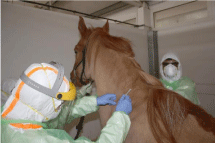
Figure 1: Subcutaneous injection of B. pseudomallei.
Inoculum
The source of the strain of B. pseudomallei used for this study was a dromedary camel that died of the infection in 1997 [6]. This strain was grown on Ashdown’s medium. The inoculum had a concentration of 6.6×107 cfu/ml. Three of the horses were infected with 2ml of the inoculum subcutaneously on the left side of the neck (Figure 1). The remaining three horses were fed a piece of bread that had been injected with 5 ml of the same inoculum.
Samples
All horses were twice daily monitored in the morning and evening and rectal temperatures were recorded.
Blood was daily withdrawn from the jugular veins for the first two weeks and then weekly afterwards until horses were euthanazed. Blood was allowed to clot and transported in cool boxes to CVRL where it was centrifuged and serum was stored at -20°C until tested. Additionally, EDTA blood was also regularly withdrawn and blood parameters tested in an automatic hematology analyzer. Serological and hematological results are reported elsewhere [5].
EDTA blood, feces and urine swabs were daily collected and bacteriologically analyzed.
All six infected horses were euthanazed within 2 months and each euthanazed horse was transported from the desert area in a leakproof truck to CVRL for necropsy.
Bacteriology
Four different types of samples were analyzed for the presence of Burkholderia pseudomallei.
• EDTA blood
• Feces
• Urine swab from stable floor surface
• Tissues including urinary bladder during necropsy
EDTA blood: 4 ml of EDTA blood was inoculated into 20ml of Brain Heart Infusion broth (Oxoid CM 1135) with 3% glycerol and incubated at 37°C aerobically for 15 days. Subcultures were regularly performed on sheep blood agar (Lab M028), Ashdown agar and Sabouraud dextrose agar (Oxoid CM 0041) and incubated at 37°C aerobically for 72 hrs.
Feces, urine swabs and tissue samples were plated on sheep blood, Ashdown and Sabouraud dextrose agars and incubated at 37°C aerobically for 72 hrs.
Necropsy
Necropsy was immediately performed after the euthanazed horses arrived at CVRL and samples from all internal organs including urinary bladder were taken for histopathology and microbiology using routine methods. Additionally, the brain was removed, and the nasal cavity opened to observe the nasal septum and conchae. After formalin fixation and paraffin embedding, 4μm thick sections were cut from all organs/lesions and stained with hematoxylin and eosin (H&E). Organ samples with gross pathological lesions were also stained according to Ziehl-Neelsen (ZN), PAS and Grocott methenamine silver stain.
Results
Outcome of the experiment
Out of the six experimentally infected horses, three, numbers 1, 2, 4 which were infected subcutaneously and one horse, number 3 challenged by the oral route, became infected with the pathogen confirmed by the re-isolation of B. pseudomallei (Table 1).
HORSE 1
Clinical signs: This horse was 30 years old, had pre-existing chronic arthritis and after the subcutaneous infection it developed fever after 3 days up to 40°C which lasted until day 8 p.i. After 8 days it developed weight loss, nasal and ocular discharge (Figures 2,3). Abscessation of the injection site was observed 7 days p.i. which opened on day 10 p.i (Figure 4). This horse was euthanazed on day 13 p.i.

Figure 2: Occular discharge 8 days post infection (p. i.).
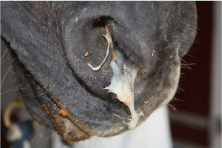
Figure 3: Mucopurulent nasal discharge 8 days p. i.

Figure 4: Abscessation of the injection site 7 days p. i.
Pathological Lesions: This gelding showed severe mucopurulent discharge from both eyes and both nostrils, but no lesions at the nasal septum or conchae were observed. The injection site at the base of the left neck revealed a golf ball sized subcutaneous abscess containing yellow-whitish pus, protruding into the muscle (Figure 5/a). Two cm apart of the injection site another abscess (15 mm in diameter) filled with pus was also found (Figure 5/b). The lymph vessel leading to the left prescapular lymph nodes were swollen and inflamed. The left prescapular lymph node was enlarged (30 mm in diameter) oedematous and contained yellowish pus (Figure 6), the right prescapular lymph node appeared normal.

Figure 5: Two subcutaneous abscesses at the injection site.

Figure 6: Left prescapular lymphnode abscess.
Both lungs were voluminous and revealed multiple subpleural abscesses of different sizes from pear like size to pin point size (Figure 7). These granulomas displayed whitish necrotic centres surrounded by a hemorrhagic to grey wall (Figure 8). Both kidneys contained several pea size whitish abscesses in the cortex (Figure 9). The wall of the urinary bladder was thickened and oedematous with massive ecchymoses in the mucosa (Figure 10).
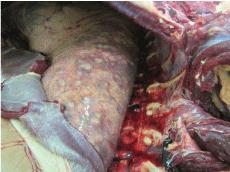
Figure 7: Subpleural lung abscesses of different size.
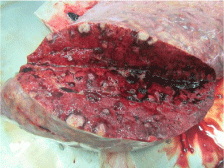
Figure 8: Lung cut surface showing whitish necrotic granulomas.

Figure 9: Pea size whitish abscesses in the renal cortex.
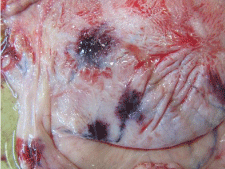
Figure 10: Thickened oedematous urinary bladder wall with massive
ecchymosis.
Histology revealed large abscesses with central necrotic debris in the lung and small abscesses in both kidneys. The wall of the urinary bladder revealed thickened subepithelial tissue due to massive distented vessels with small hemorrhages in the submucosa (Figure 11).

Figure 11: Histology of the urinary bladder wall revealing hemorrhages.
HORSE 2
Clinical signs: This horse was 31-years-old. For a long time, it had developed a “rocked backed stance” which constantly increased due to previous chronic ailments. After the subcutaneous injection, it developed 48 hrs later a severe swelling at the injection site which remained until euthanasia 31 days p.i. It developed no fever, but mucopurulent discharge from both nostrils for several days and a swelling at the right side of the brisket.
Pathological lesions: At necropsy the gelding showed nasal discharge, but no lesions at the nasal septum or conchae were observed. The injection site at the base of the left neck revealed a tennis ball sized subcutaneous abscess containing yellowish pus, protruding into the muscle. The left prescapular lymph node was not enlarged and appeared normal. Both lungs were voluminous and showed large greyish plaques at the dorsal areas, the larger ones with hemorrhagic demarcation (Figure 12). On the cut surface of these areas marked hemorrhagic oedema and hepatisation was visible (Figure 13). The mediastinal lymph nodes were swollen and dark red.

Figure 12: Dorsal lung surface with greyish plaque and hemorrhages.

Figure 13: Lung cut surface with hemorrhagic oedema.
Both kidneys revealed no visible lesions. However, the wall of the urinary bladder was thickened and oedematous with focal hemorrhages in the mucosa (Figure 14). Microscopy revealed massive thickened subepithelial tissue due to granulomatous inflammation with small necrosis in the wall of the urinary bladder and massive distented vessels with small hemorrhages in the submucosa (Figure 15). Microabscesses were found in both kidneys and larger abscesses with central necrotic debris in the lungs.
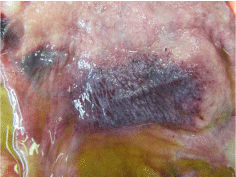
Figure 14: Oedematous urinary bladder wall with mucosal hemorrhages.
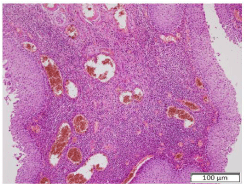
Figure 15: Histology of the urinary bladder wall showing granulomatous
inflammation.
HORSE 3
Clinical signs: This 26 year old horse was orally infected. Twelve days after the oral infection it developed a severe swelling of the left chest area followed by severe weight loss. It did not develop fever, but lameness of both front legs. The horse was euthanazed at 37 days p.i.
Pathological lesions: At necropsy this mare showed no ocular or nasal discharge and no lesions at the nasal septum or conchae were observed. The left prescapular lymph node was not enlarged and appeared normal. Both lungs were voluminous and with multiple parenchymal hemorrhages. The right lung had a hemorrhagic area of tennis ball-size containing clotted blood. The urinary bladder showed alternate areas of white and pale pink mucosa.
Even under the microscope no abscesses in the lung and kidneys were found. The wall of the urinary bladder showed mild thickened subepithelial tissue due to focal granulomatous inflammation and small hemorrhages in the submucosa.
HORSE 4
Clinical signs: This horse was 28 years of age. After the s.c. infection it developed slight fever up to 38.6°C on day 14 p.i. for several days. Abscessation at the site of injection was observed from day 4 p.i. and from day 17 p.i. it developed a severe swelling, the size of a golf ball of the left retropharyngeal lymph node. No nasal or ocular discharge were observed. It lost weight and stopped eating from day 40 p.i. The horse was euthanazed on day 44 p.i.
Pathological lesions: At necropsy this gelding of 414 kg showed no ocular or nasal discharge and no lesions at the nasal septum or conchae were observed. The injection site at the base of the left neck revealed two hematomas: one small, the size of a coin, solid, under the skin; another, bigger one, the size of a golf ball, affecting muscles. The left prescapular lymph node was not enlarged and appeared normal. Both kidneys and the urinary bladder revealed no visible lesions.
Histology revealed no abscesses in the lung and kidneys, but mild granulomatous inflammation in the submucosa of the urinary bladder.
The orally infected horses 5 and 6 were euthanazed on day 51 and day 58 p.i. due to chronic lameness and chronic suspensory ligament injury. Both horses remained serologically negative and B. pseudomallei was not isolated from tissue samples taken during necropsy.
Histology revealed no abscesses in the lung and kidneys as well as no inflammation or hemorrhages in the mucosa/submucosa of the urinary bladder.
Table 1 shows the clinical signs and pathological lesions of the 6-euthanased horses in summary.
Animal ID, Route of infection
Sample
Culture Media
Growth strength of B. pseudomallei
Horse 1, subcutaneous
EDTA blood
Sheep blood agar Ashdown agar Sabouraud dextrose agar
Urine swab
Right and left lung
Kidney
Urinary bladder
Injection site
Left prescapular lymph node
Horse 2, subcutaneous
Urine- 100µl
Sheep blood agar Ashdown agar Sabouraud dextrose agar
78 colonies 19 colonies 63 colonies
Urine swab
Sheep blood agar Ashdown agar Sabouraud dextrose agar
Urinary bladder
Injection site
Horse 3, oral
Tonsil
Sheep blood agar Ashdown agar Sabouraud dextrose agar
Horse 4, subcutaneous
Urinary bladder
Sheep blood agar Ashdown agar Sabouraud dextrose agar
Table 1: Summary of clinical signs and pathological lesions observed in 6 horses infected with B. pseudomallei.
Bacteriology
Table 2 shows the culture results. B. pseudomallei from different organs and EDTA blood from all subcutaneous infected horses and from one orally infected horse.
Horse ID
Age in years
Route of infection
Clinical signs
Loss of weight
Abscess at injection site
Euthanazed days p.i
Pathology
1
30
Sub cutaneous
Fever (40°C), nasal and ocular discharge
Yes
Yes, opened
13
Pulmonary and renal abscesses; acute hemorrhagic cystitis. No lesions in nasal septum/ conchae
2
31
Sub cutaneous
No fever, mucopurulent nasal discharge
No
Yes, swelling not opened
31
Pulmonary hemorrhages; subacute pyogranulative cystitis. No lesions in nasal septum/ conchae
3
26
Oral
No fever, lameness of both front legs swelling at chest, no nasal or oral discharge
Yes
Swelling left chest
37
Granulative cystitis. No pulmonary and renal lesions. No lesions in nasal septum/conchae.
4
28
Sub cutaneous
Slight fever (38.6°C), weight loss, stopped laming, no ocular or nasal discharge
Yes
Yes, opened
44
Granulative cystitis. No pulmonary and renal lesions. No lesions in nasal septum/conchae.
5
20
Oral
None
No
No
51
No pathological lesions.
6
29
Oral
None
No
No
58
No pathological lesions.
Table 2: B. pseudomallei culture results.
Discussion
Six horses were experimentally challenged with a strain of B. pseudomallei isolated from a fatal dromedary camel infection with typical pyogenic granulomas in different organs [7]. Three horses were inoculated subcutaneously and 3 administered the bacterium by the oral route. Although all horses received high doses of the pathogen, only 4 of them developed clinical signs and pathological lesions of different severity. Also, from those 4 horses the pathogen was re-isolated from different organs using different culture media. All 3 subcutaneously infected horses became sick as well as one orally infected horse. Two orally infected horses remained healthy throughout the trial. This cannot be easily explained, but the wide range of different clinical preservations indicates that both, host factors and infection dose are most probably important determining the severity of the disease. It seems that a higher infection dose or repeated challenges are crucial for an orally induced infection.
Additionally, most probably euthanasia of these orally infected horses occurred too early as the incubation period ranges from a few days to several months. Although hamsters were found to be the most susceptible laboratory animals to Melioidosis, oral inoculation often gave irregular challenge results [8]. The horses chosen for the experiment were old above 20 years and all of them had chronic ligament and bone ailments which may also have contributed to clinical signs and lesions observed. B. pseudomallei has an extremely broad host range including farm animals, wildlife and human beings. Melioidosis presents itself in many different clinical forms as experienced also with this experiment. It also comes in many different pathological alterations.
With this experiment we showed that none of the 6 infected horses developed any lesions in the nasal conchae or nasal septum, although 2 of them exhibited nasal and ocular discharge. These lesions are pathognomic in glanderous animals including camels (OIE Terrestrial Manual 3, 9). Similar observations were made by Klocke [10] in BALB/c-mice and C57BI/6 mice who challenged these mice with different B. pseudomallei strains. Very few pathological alterations were observed in the mice’noses.
Other lesions seen in these experimentally infected horses were similar to those infected with B. mallei. They included formation of reddish nodular abscesses with a central grey necrotic zone in the lung and pyogranulomatous nodules in other organs. These abscessations are indistinguishable from Glanders pyogranulomas [9].
Interestingly, three subcutaneously infected horses had developed hemorrhagic, oedematous urinary bladder. From all 3 horses B. pseudomallei was re-isolated from the urinary bladder and urine swabs taken from the stable surface floors. B. pseudomallei is often cultured from environmental sources mainly mud and swamp water. It seems that the pathogen has an affinity to moist and wet environments. This is an important information as urine should be collected when dealing with Melioidosis.
Lungs and kidneys of the first two horses revealed similar microscopic lesions, but to a different degree: large pulmonic abscesses with central necrotic debris were found in both horses. However, histology revealed small abscesses in the kidneys of the first horse, but microabscesses in both kidneys of the second horse. Experimental infection of mice with B. pseudomallei induced small pulmonary pyogranulomas [10] with similar distribution like in these 2 horses. Neither macroscopic, nor microscopic lesions were found in lungs and kidneys of the other 4 horses.
The lung also seems to be a prime target organ in naturally B. pseudomallei-infected sheep and goat in Australia, with 100% and 63% of affected animals developing pulmonary lesions [11]. However, renal lesions were found in only 14% and 30% of these sheep and goat.
Thickened urinary bladder in the first experimental infected horse was caused by massive distended vessels with small hemorrhages in the submucosa, but due to severe granulomatous inflammation with small necrosis and massive distended vessels in the second experimental infected horse. Mild granulomatous inflammation caused thickening of the urinary bladder in experimental infected horses 3 and 4. Neither macroscopic, nor microscopic lesions were found in the urinary bladder of the other 2 experimental infected horses. No lesion of urinary bladder was reported in experimental infected mice [10].
Ladds et. al [12] reported an acute meningoencephalomyelitis caused by naturally B. pseudomallei infection of a horse, which was not seen in our experimental infected horses.
B. pseudomallei is one of the most dangerous bacteria to work within a laboratory and therefore the preparation of the inoculum and culture was performed in CVRL’s biosafety laboratory L3. Organ samples, EDTA blood, abscess and urine swabs were streaked on sheep blood, Ashdown and Sabouraud agars. All 3 agars are excellent for the recovery of B. pseudomallei but as seen from Table 2 blood agar and Sabouraud were superior to Ashdown agar.
Animal welfare issue
An Ethic Commission comprising 4 veterinarians of the Central Veterinary Research Laboratory (CVRL) and a government veterinarian from the Ministry of Climate Change and Environment (MOCCAE), United Arab Emirates follow the Ministerial Decree No. 384 of the year 2008 on the executive by-law of the Federal Law No. 16 of the year 2007 concerning Animal Welfare. The welfare of all experimental animals and treatment of them conducted by the Central Veterinary Research Laboratory (CVRL) are reviewed and approved by the Animal Ethic Committee of Central Veterinary Research Laboratory (CVRL) and Ministry of Climate Change and Environment (MOCCAE) of the United Arab Emirates (Permit Number:550353).
The trial followed the recommendations of the Ethic Commission and therefore ethical clearance was granted in January 2018 for the infection experiment of 6 horses with Burkholderia pseudomallei. It should be mentioned again that the 6 horses were above 25 years of age and all were previously selected for euthanasia due to long history of bone and ligament ailments. Handling procedures and sampling frequency were designed to reduce stress and health risks for the horses, according to United Arab Emirates Federal Law No. 16 (2007) concerning Animal Welfare.
Acknowledgement
The authors herewith express their gratitude to H. H. Sheikh Mohammed Bin Rashid Al Maktoum, Vice President and Prime Minister of the United Arab Emirates and Ruler of Dubai as well as Saeed Al Tayer, Chairman of Dubai Racing Club and Dr. Ali Ridha, Director General of the Central Veterinary Research Laboratory. We thank the following persons who helped us with this project: Brenda Cooke, Heather Copland, Zulfiqar Ali Kiani, Tahir Zaman, grooms: Shyam Singh and Karan Singh.
References
- Limmathurotsakul D, Golding N, Dance DA, Messina JP, Pigott DM, Moyes CL, et al. Predicted global distribution of Burkholderia pseudomallei and burden of melioidosis. Nat Microbiol. 2016; 1.
- Godoy D, Randle G, Simpson AJ, Aanensen DM, Pitt TL, Kinoshita R, et al. Multilocus sequence typing and evolutionary relationships among the causative agents of Melioidosis and Glanders, Burkholderia pseudomallei and Burkholderia mallei. J Clin Microbiol. 2003; 2068-2079.
- OIE. Manual of diagnostic tests and vaccines for terrestrial animals. 2018.
- Lefèvre P-Ch. Melioidosis. In: Infectious and parasitic diseases of livestock, Ed: Lefèvre P-Ch, Blancou J, Chermette R, Uilenberg G Lavoisier. Paris. 2010; 1189-1196.
- Wernery U, Rodriguez Caveney M, Maio E, Wernery R, Raghavan R, Laroucau K, et al. Evaluation of serological responses of horses challenged with Burkholderia pseudomallei using current diagnostic tests for Glanders. Veterinaria Italiana. 2019.
- Wernery R, Kinne J, Haydn-Evans and Ul-Haq A. Melioidosis in a seven year olf camel, a new disease in the United Arab Emirates (UAE). J Camel Pract and Research. 1997; 4: 141-143.
- Wernery U, Kinne J, Schuster RK. Camelid Infectious Disorders. OIE Book. 2014; 54-57.
- Miller WR, Pannell L, Cravitz L, Tanner WA, Rosebury T. Studies on certain biological characteristics of Malleomyces mallei and Malleomyces pseudomallei II Virulence and infectivity for animals. 1948; 127-135.
- Wernery U, Altemann D, Kinne J, Wernery R. Pictorial guide to the diagnosis of Glanders in horses, donkeys and camels. OIE Glanders Brochure. 2012.
- Klocke S. Mechanismen der Antikörper-vermittelten Immunität des Respirationstraktes bei Infektionen mit Burkholderia pseudomallei. Thesis achieved at the Veterinary School, Hanover, Germany. 2004.
- Choy JL, Mayo M, Janmaat A, Currie BJ. Animal melioidosis in Australia. Elsevier Science B.V. Acta Tropica. 2000; 74: 153-158.
- Ladds PW, Thomas AD, Pott B. Melioidosis with acute meningoencephalomyelitis in a horse. Aust Vet J. 1981; 57: 36.